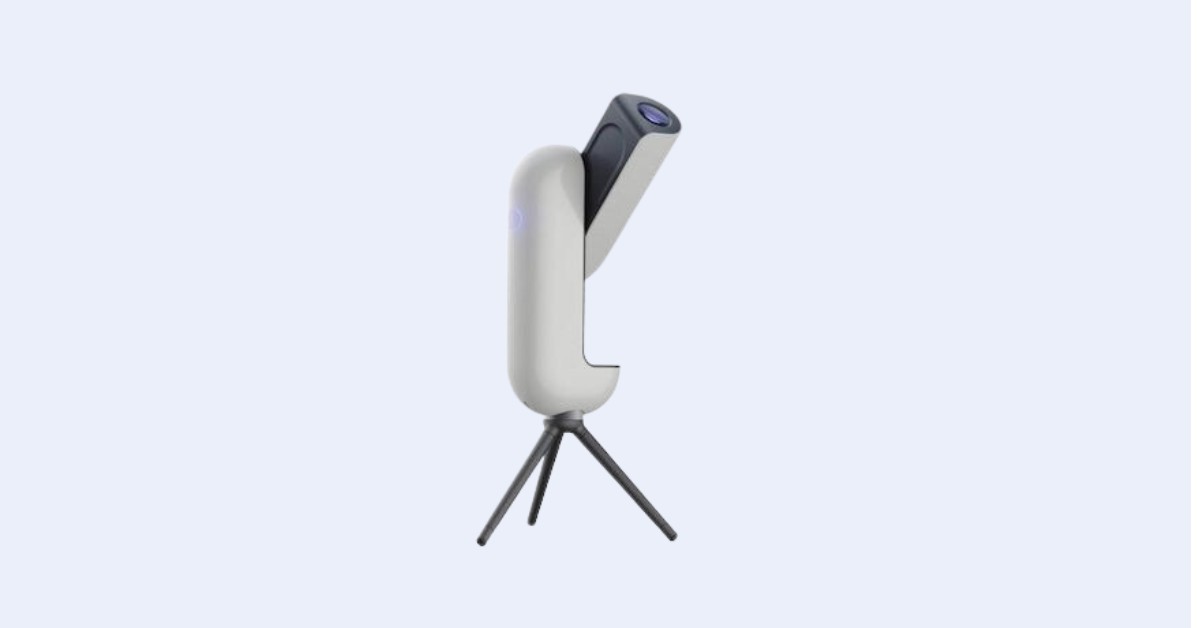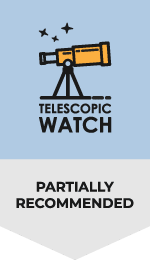bgyvhnmnhbgfdfghj klmnh bhvgtcfrd4xThe Optical Tube’s Design
Looking at the optical tube of the Vaonis Vespera, I’m struck by its sleek and simple design, consisting of a 50mm (2”) f/4 Petzval apochromatic quadruplet refractor with a 200mm focal length. The whole thing is housed in a shiny white plastic shell.
The tiny aperture and lightweight materials make the telescope weigh in at only 11 pounds, making it one of the tiniest “smart” telescopes I’ve seen on the market today. The entire assembly is made almost exclusively out of plastic, which is okay for keeping things light, but I would worry that the Vespera could suffer pretty bad damage if dropped too hard.
The “apochromatic quadruplet” optical design used in Vespera is actually a Petzval, which consists of two groups of double lanthanum and FPL52 glass lenses, making the views mostly free of any chromatic aberration, astigmatism, or field curvature. Because Vaonis opted for a refractor design rather than a reflector like the Unistellar eVscope 2, collimation isn’t something I have to worry about with the Vespera.
Peering into the tube, there’s not much there besides the black interior, the individual lens elements, and the sensor toward the back of the scope. The inside walls are decently non-reflective, which is important for preventing unwanted stray light from entering the telescope as well as increasing contrast in the images.
The front of the telescope also has an attachment point for adding optional accessories such as the Vespera solar filter, dual-band filter, or light pollution filter.
The Inadequate Camera Sensor
The camera sensor included in the Vespera package is the Sony IM462 sensor, a tiny 2-megapixel device used in popular planetary cameras like the ZWO ASI462MC. Unfortunately, this tiny sensor makes for very underwhelming images at this telescope’s price point. The Vespera’s larger cousin, the Stellina, offers a much wider, superior 6.4 megapixel IMX178 sensor, which drastically improves the image quality.
Ideally, for something this expensive, I would have expected the Vespera to include a much higher-quality imaging device, but Vaonis definitely did not seem to bother and instead focused on the portability aspect of the package.
The Software: Singularity by Vaonis
The magic that makes the Vespera work lies within the included software, available on Apple and Android smartphones and tablets. Up to five devices can simultaneously connect to Vespera’s WiFi network access point to use the Singularity app. The app serves as a hub for controlling the Vespera telescope.
Upon opening the app and connecting, the alignment process begins by using our smartphone or tablet’s GPS location. After that, it takes a few minutes to orient itself, using its internal database and astrometry algorithm to plate-solve sample images.
While the Singularity app and Vespera do just about everything automatically for us by default, we can still manually control the telescope’s movements, focus, and exposure settings in the app if we so desire. We can also export any images taken as JPEGs or even raw file formats such as TIFF or FITS, so we can do our own post-processing on a computer.
One disappointing caveat of the Singularity app is the severe lack of objects in its provided catalog. To date, there are somewhere around 300 objects in Singularity’s database, with more being added with each software update. You can manually enter coordinates into the app if you wish to image an object outside the database, but that’s far less convenient.
The Adequate Fork Mount
The Vespera is mounted on a single motorized fork arm with the same shiny white plastic used on the optical tube, giving it a very uniform and modern appearance. Included in the package as well is a short, telescoping aluminum tripod with a bubble level.
I believe the standard tripod is mostly adequate, but the Vespera can also be used with any normal camera tripod or Vaonis’s own high tripod.
Luckily, the telescope is small and light enough that the standard 3/8”-16 center thread is seemingly enough to hold the Vespera steady. However, the included tripod does not come with any form of shock absorption on the feet, which can leave the telescope prone to disturbance by nearby vibrations or wind.
Performance on Deep Sky Objects and Planets
The Vaonis Vespera can capture most globular and open clusters with bright, well-resolved images, given that I’ve stacked enough subframes for a long enough period. However, light pollution can affect its performance. Darker skies or a light pollution filter are preferable for the best viewing experience.
While bright targets like M31 or M82 can be captured from light-polluted areas, their images aren’t as contrasty as I like. The Orion Nebula (M42) and Lagoon Nebula (M8) are awesome targets for the Vespera, even in moderately light-polluted areas. The mosaic mode and short focal length also make it ideal for capturing extensive and large deep-sky objects like M45 or the Veil Nebula complex.
Unfortunately, the Vespera has limitations when it comes to Solar System targets due to its tiny aperture and extremely short focal length. Most of the planets, especially smaller ones like Venus and Mars, mostly appear as unresolved disks. Some basic detail on Saturn and Jupiter is possible, but the Vespera is just simply not capable enough to get in close on them.
Should I buy a Used Vaonis Vespera?
Because the Vespera is an all-in-one integrated system, it’s not something with parts that are easily replaceable or repairable, so I do not recommend purchasing one used.
Vaonis does offer a 2-year warranty from the day you receive the telescope that covers material defects, but it is void if the telescope was abused or modified in any form, either by you or the previous owner, which may be hard to determine if you are purchasing used.
Alternative Recommendations
In addition to considering an a la carte astrophotography setup with a separate camera, OTA, and mount (which I’ve picked plenty of recommendations for), there are a few specific instruments you may want to look at instead of the Vespera.
- The Vaonis Stellina is a similar all-in-one package to the Vespera, but larger and more capable with a wider aperture and sensor.
- The Celestron Nexstar Evolution 8 is multiple times heavier than the Vespera but also has a good built-in battery and wifi. You can observe with this telescope using either an eyepiece or a camera of your choice for electronically assisted astronomy.
- The Sky-Watcher 12” Flextube Collapsible Dobsonian is a great choice for those who want a hefty aperture while still wanting some portability. A GoTo version is available as well, but it’s not a single integrated package like Vespera.
Aftermarket Accessories Recommendations
Vaonis offers a number of optional accessories for the Vespera that make for nice upgrades. One of the best quality-of-life upgrades is the hygrometer sensor. This little device attaches very easily to the front of the telescope with a single screw and allows you to use the “anti-fog” system, activating the Vespera’s internal dew heater when a certain temperature or humidity threshold is reached. Alternatively, you could just purchase a dew shield or dew heater strap, but the integrated hygrometer sensor may be worth it for the $99 price tag.
Vaonis also offers three different clip-on filters for the front of the telescope: a solar filter, a dual-bandpass filter, and a light pollution filter. Whether those are necessary is dependent on your priorities and your location.
- The light pollution filter would definitely come in handy if you’re an urban observer, blocking emissions from sodium and mercury lamps, as well as a few other unwanted natural lighting sources.
- The Vaonis dual-band nebula filter is another nifty accessory for the Vespera, allowing a 12nm bandpass for OIII and Ha emission lines, which increases contrast on emission nebulae and supernova remnants, as well as sharpens the stars overall.
- Lastly, the solar filter opens up the possibility of using the telescope for sunspot observation. Please note that you should NOT point the Vespera at the sun without the filter securely in place. While it can’t hurt your eyes with this particular telescope, it can permanently damage the camera sensor or even set the telescope on fire (as well as certainly void your warranty).
If you plan on traveling anywhere with this telescope, I also recommend investing in a padded backpack or case, whether that be the proprietary Vespera backpack or another suitable aftermarket one.
Optionally, if you’d like the telescope to stand further off the ground, you can also invest in a taller tripod. Vaonis’s high tripod is incredibly overpriced for what it is, but luckily you can get away with using Vespera on most standard camera tripods that utilize a ⅜”-16 threaded screw.



